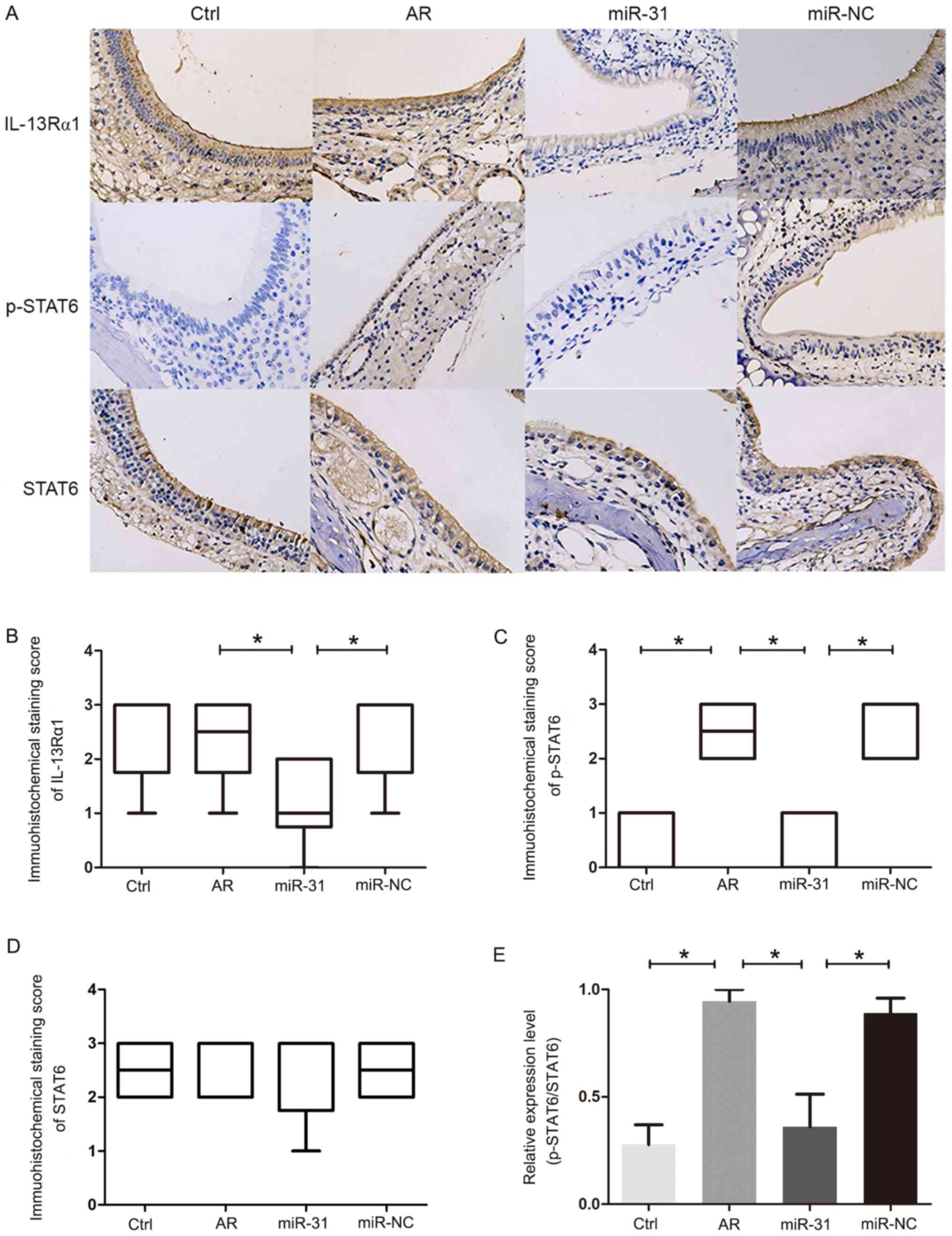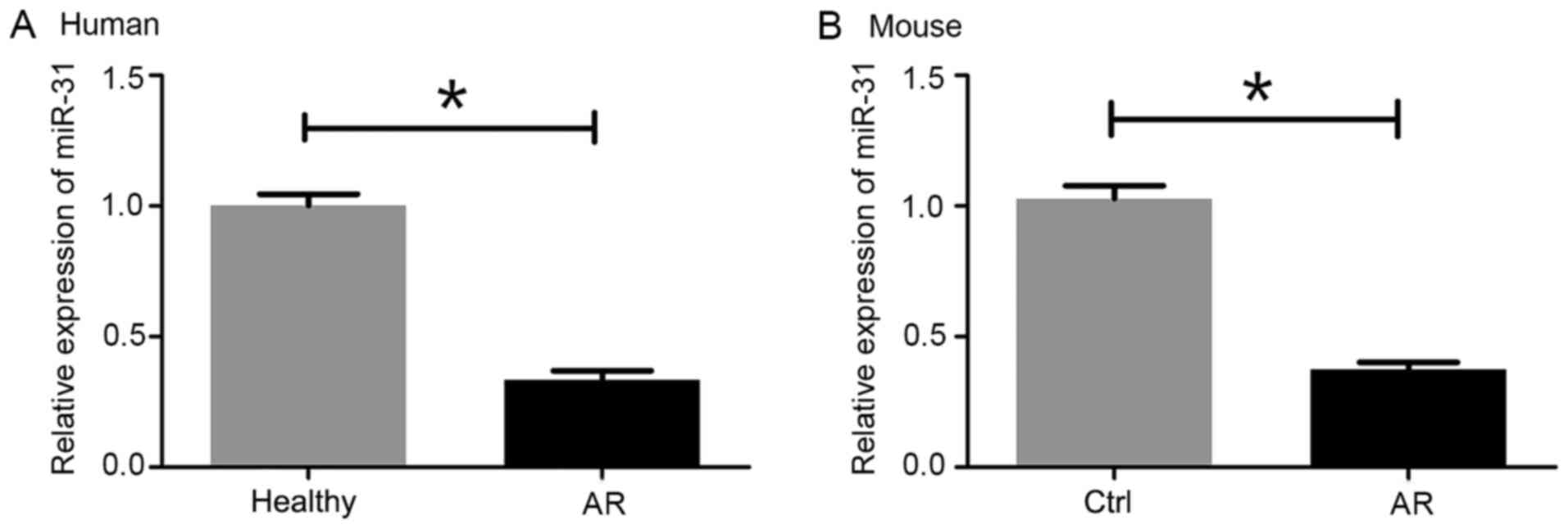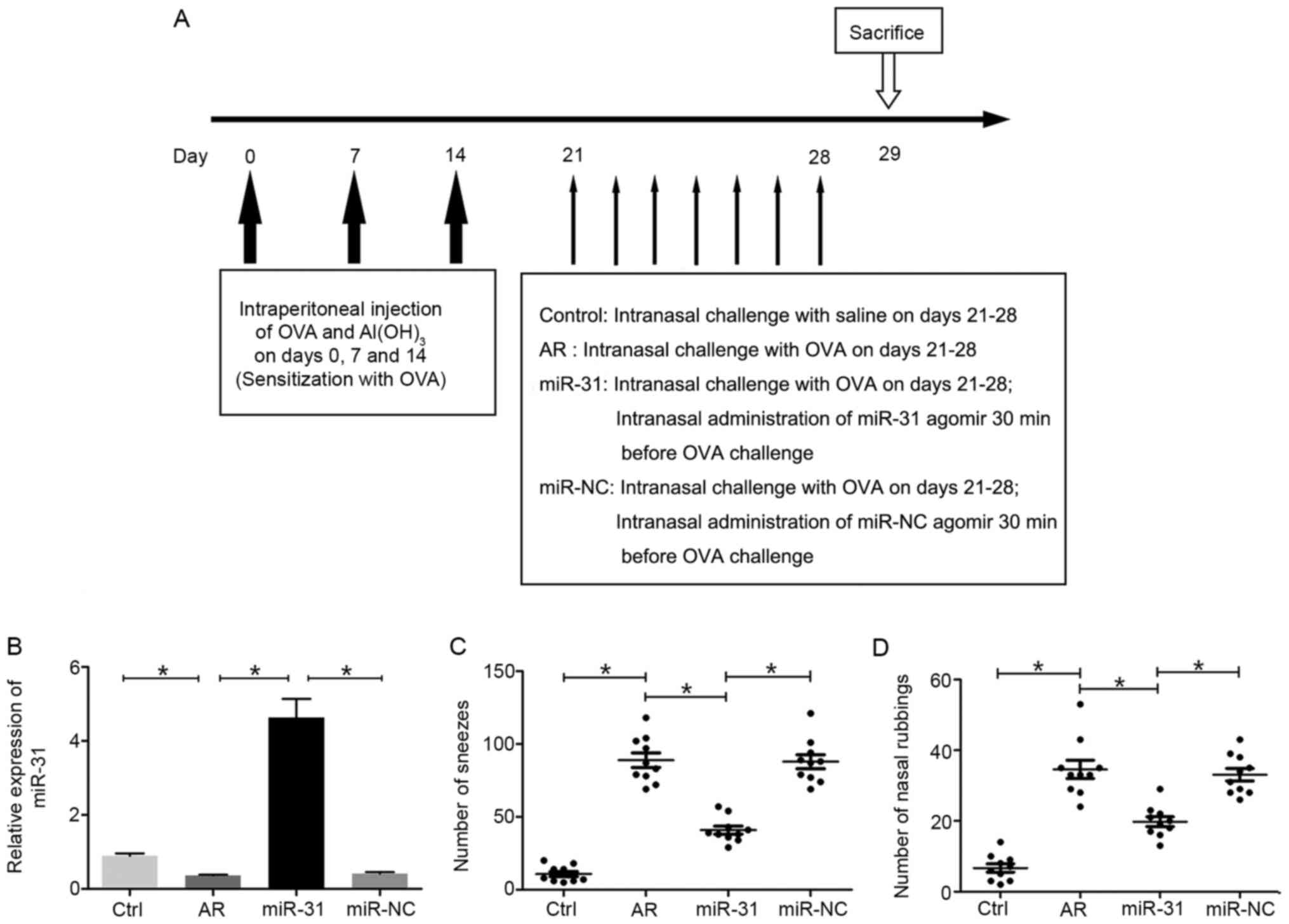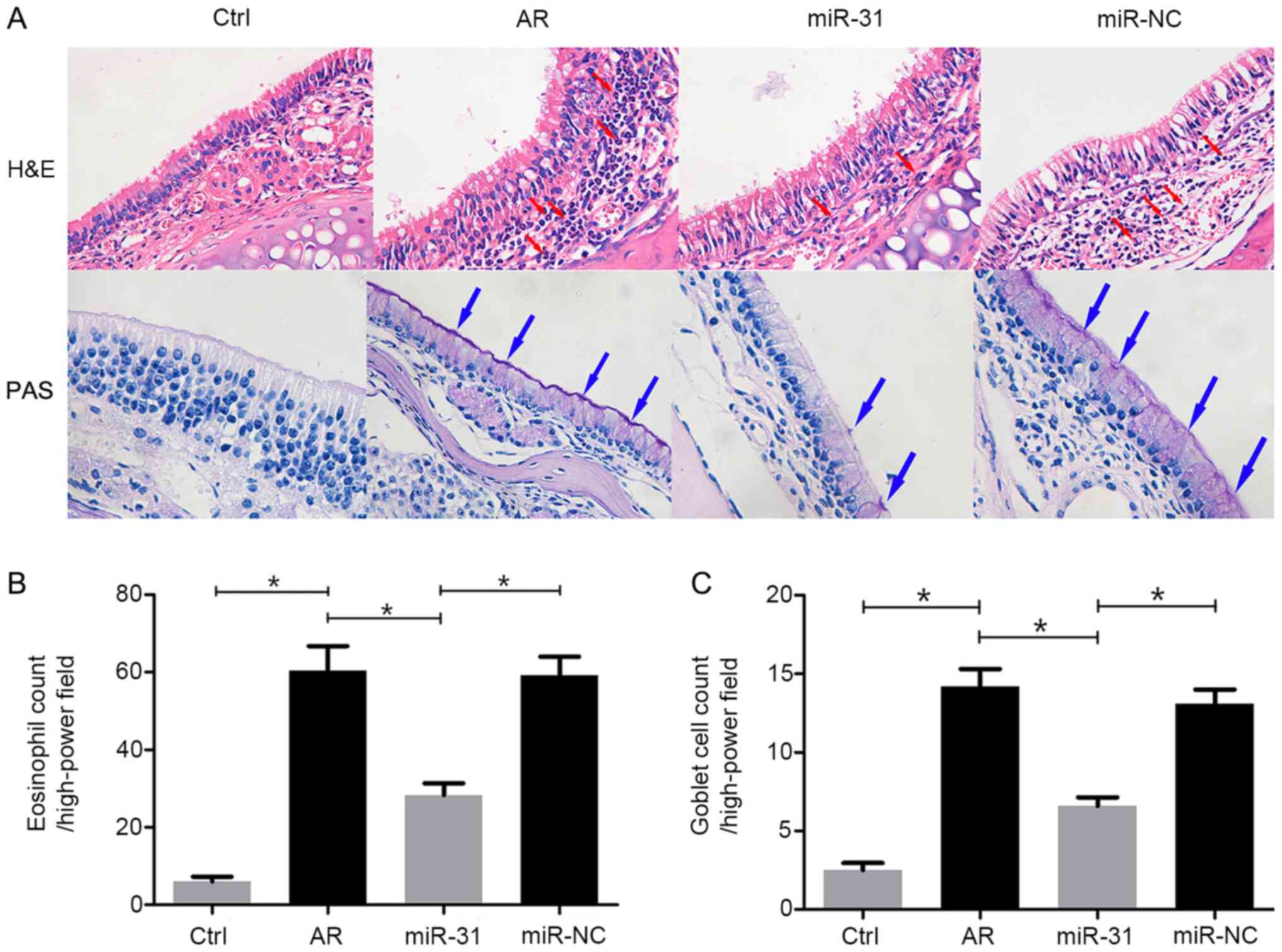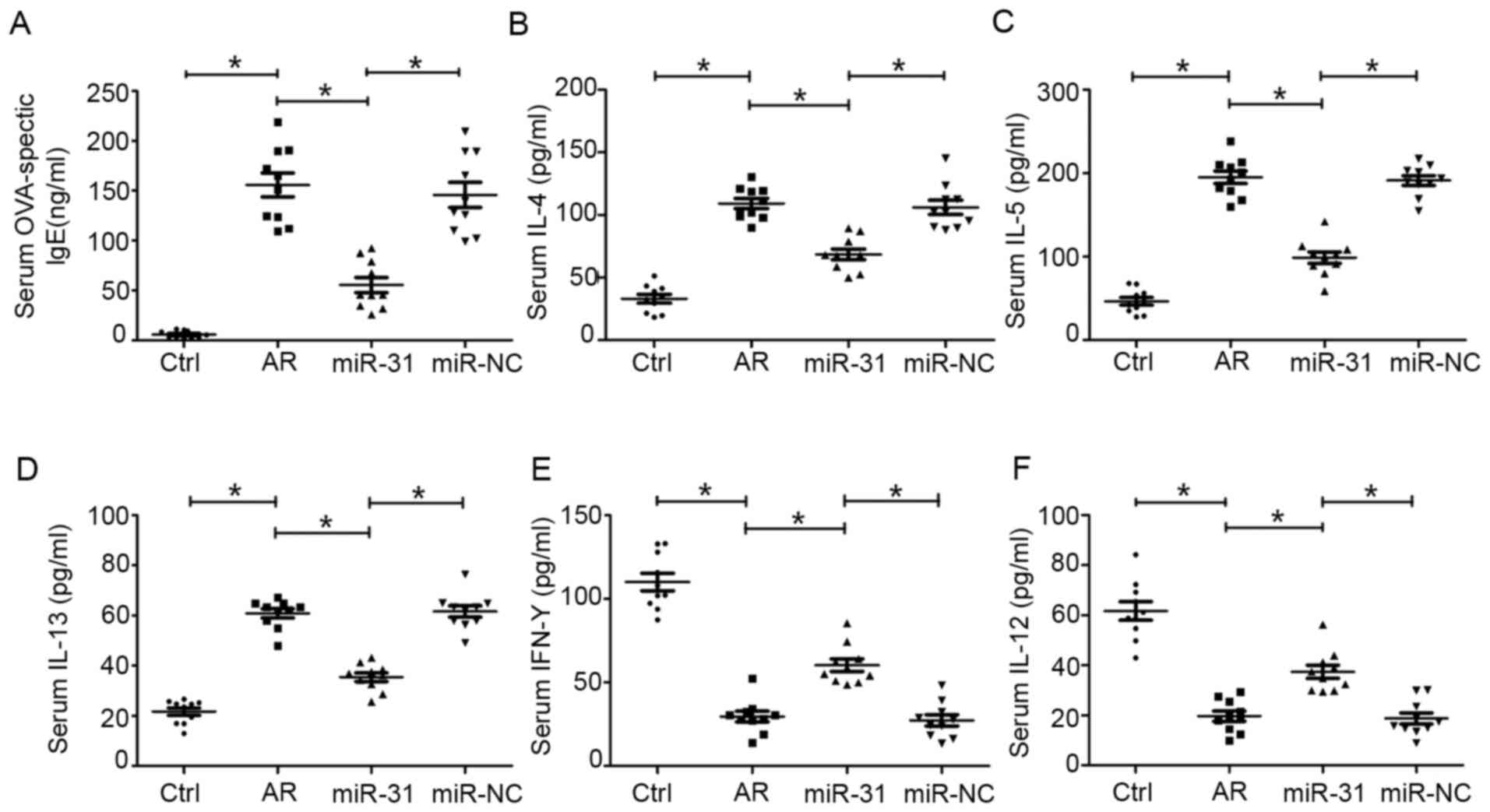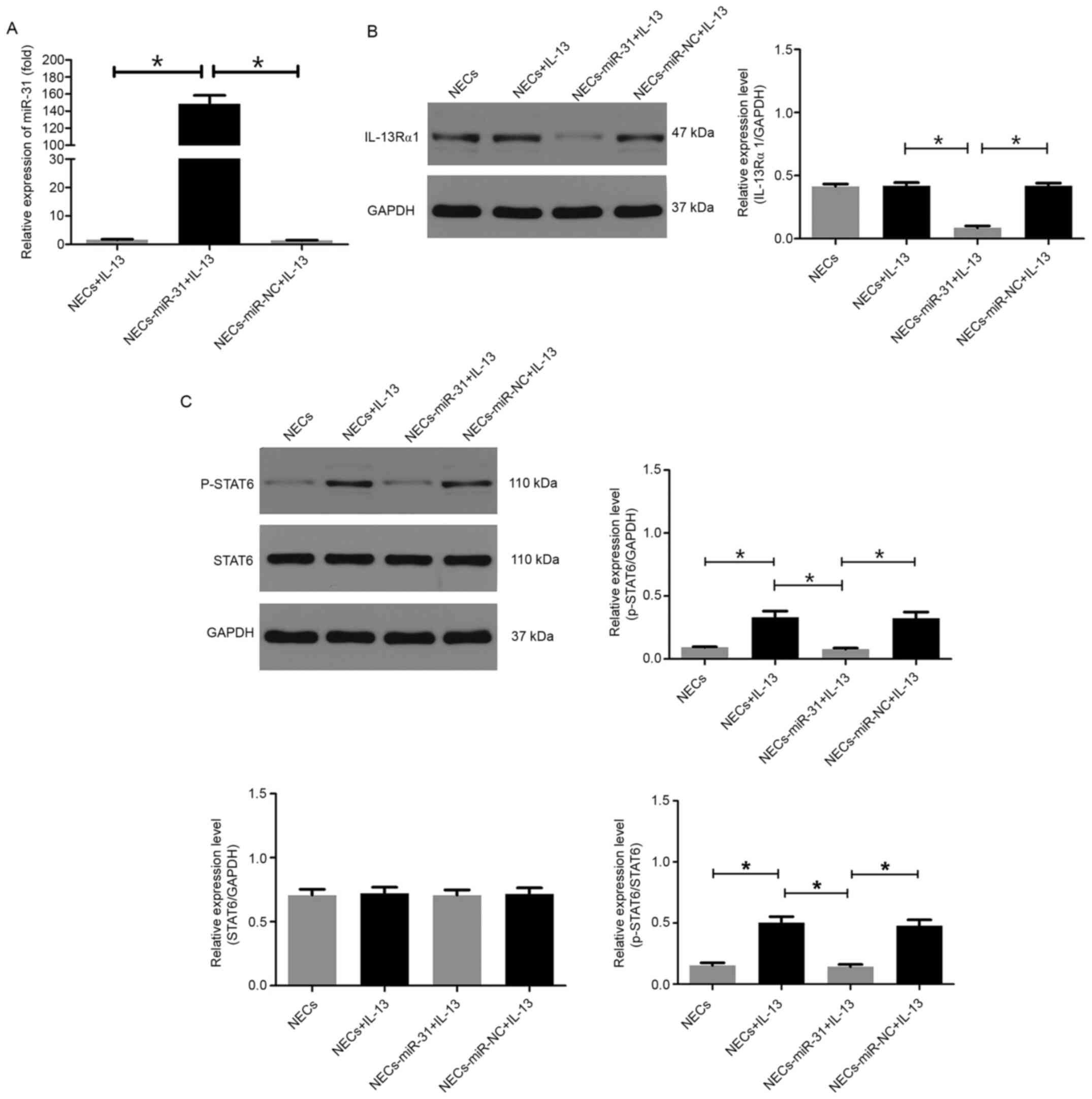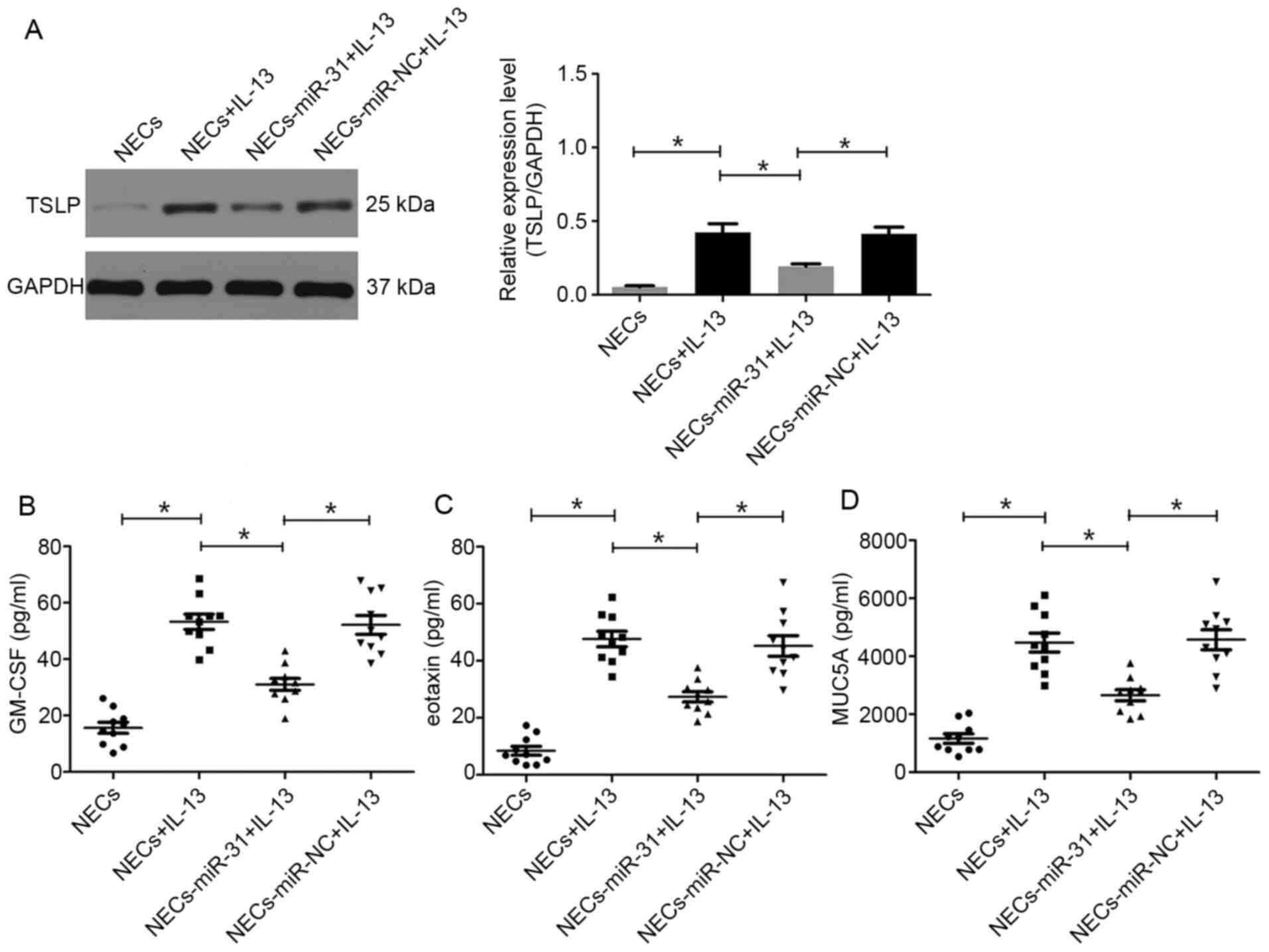|
1
|
Brożek JL, Bousquet J, Agache I, Agarwal
A, Bachert C, Bosnic-Anticevich S, Brignardello-Petersen R,
Canonica GW, Casale T, Chavannes NH, et al: Allergic rhinitis and
its impact on asthma (ARIA) guidelines-2016 revision. J Allergy
Clin Immunol. 140:950–958. 2017. View Article : Google Scholar : PubMed/NCBI
|
|
2
|
Katelaris CH, Lee BW, Potter PC, Maspero
JF, Cingi C, Lopatin A, Saffer M, Xu G and Walters RD: Prevalence
and diversity of allergic rhinitis in regions of the world beyond
Europe and North America. Clin Exp Allergy. 42:186–207. 2012.
View Article : Google Scholar : PubMed/NCBI
|
|
3
|
Scadding G: Cytokine profiles in allergic
rhinitis. Curr Allergy Asthma Rep. 14:4352014. View Article : Google Scholar : PubMed/NCBI
|
|
4
|
Almeida MI, Reis RM and Calin GA: MicroRNA
history: Discovery, recent applications, and next frontiers. Mutat
Res. 717:1–8. 2011. View Article : Google Scholar : PubMed/NCBI
|
|
5
|
Bartel DP: MicroRNAs: Target recognition
and regulatory functions. Cell. 136:215–233. 2009. View Article : Google Scholar : PubMed/NCBI
|
|
6
|
Li L, Hui Y and Xing C: MicroRNA-31
affects the expression of asthma-related cytokines via regulation
of CD44. Int J Clin Exp Med. 9:112016.
|
|
7
|
Fan W, Liang D, Tang Y, Qu B, Cui H, Luo
X, Huang X, Chen S, Higgs BW, Jallal B, et al: Identification of
microRNA-31 as a novel regulator contributing to impaired
interleukin-2 production in T cells from patients with systemic
lupus erythematosus. Arthritis Rheum. 64:3715–3725. 2012.
View Article : Google Scholar : PubMed/NCBI
|
|
8
|
van der Heide V, Möhnle P, Rink J, Briegel
J and Kreth S: Down-regulation of MicroRNA-31 in CD4+ T
cells contributes to immunosuppression in human sepsis by promoting
TH2 skewing. Anesthesiology. 124:908–922. 2016. View Article : Google Scholar : PubMed/NCBI
|
|
9
|
Whiteoak SR, Claridge A, Balendran CA,
Harris RJ, Gwiggner M, Bondanese VP, Erlandsson F, Hansen MB,
Cummings JR and Sanchez-Elsner T: MicroRNA-31 targets thymic
stromal lymphopoietin in mucosal infiltrated CD4+ T
cells: A Role in Achieving Mucosal Healing in Ulcerative Colitis?
Inflamm Bowel Dis. 24:2377–2385. 2018. View Article : Google Scholar : PubMed/NCBI
|
|
10
|
Gwiggner M, Claridge A, Cummings F and
Sanchez-Elsner T: OC-162 the role of micrornas miR-31 and miR-155
in the deregulation of the IL-13 pathway in ulcerative colitis.
Gut. 61 (Suppl 2):A69–A70. 2012. View Article : Google Scholar
|
|
11
|
Gwiggner M, Martinez-Nunez RT, Whiteoak
SR, Bondanese VP, Claridge A, Collins JE, Cummings JR and
Sanchez-Elsner T: MicroRNA-31 and MicroRNA-155 Are Overexpressed in
ulcerative colitis and regulate IL-13 signaling by targeting
interleukin 13 receptor α-1. Genes (Basel). 9:852018. View Article : Google Scholar
|
|
12
|
Niu Y, Murata T, Watanabe K, Kawakami K,
Yoshimura A, Inoue J, Puri RK and Kobayashi N: MIP-T3 associates
with IL-13Ralpha1 and suppresses STAT6 activation in response to
IL-13 stimulation. FEBS Lett. 550:139–143. 2003. View Article : Google Scholar : PubMed/NCBI
|
|
13
|
Ramalingam TR, Pesce JT, Sheikh F, Cheever
AW, Mentink-Kane MM, Wilson MS, Stevens S, Valenzuela DM, Murphy
AJ, Yancopoulos GD, et al: Unique functions of the type II
interleukin 4 receptor identified in mice lacking the interleukin
13 receptor alpha1 chain. Nat Immunol. 9:25–33. 2008. View Article : Google Scholar : PubMed/NCBI
|
|
14
|
Cheng L, Chen J, Fu Q, He S, Li H, Liu Z,
Tan G, Tao Z, Wang D, Wen W, et al: Chinese society of allergy
guidelines for diagnosis and treatment of allergic rhinitis.
Allergy Asthma Immunol Res. 10:300–353. 2018. View Article : Google Scholar : PubMed/NCBI
|
|
15
|
Tan L, Qiu T, Xiang R, Cao C, Deng Y, Tao
Z and Xu Y: Down-regulation of Tet2 is associated with Foxp3 TSDR
hypermethylation in regulatory T cell of allergic rhinitis. Life
Sci. 241:1171012020. View Article : Google Scholar : PubMed/NCBI
|
|
16
|
Wang L, Lv Q, Song X, Jiang K and Zhang J:
ADRB2 suppresses IL-13-induced allergic rhinitis inflammatory
cytokine regulated by miR-15a-5p. Hum Cell. 32:306–315. 2019.
View Article : Google Scholar : PubMed/NCBI
|
|
17
|
Xiang R, Xu Y, Zhang W, Kong YG, Tan L,
Chen SM, Deng YQ and Tao ZZ: Semaphorin 3A inhibits allergic
inflammation by regulating immune responses in a mouse model of
allergic rhinitis. Int Forum Allergy Rhinol. 9:528–537. 2019.
View Article : Google Scholar : PubMed/NCBI
|
|
18
|
Livak KJ and Schmittgen TD: Analysis of
relative gene expression data using real-time quantitative PCR and
the 2(−ΔΔC(T)) method. Methods. 25:402–408. 2001. View Article : Google Scholar : PubMed/NCBI
|
|
19
|
Wang J, Cui Z, Liu L, Zhang S, Zhang Y,
Zhang Y, Su H and Zhao Y: MiR-146a mimic attenuates murine allergic
rhinitis by downregulating TLR4/TRAF6/NF-κB pathway. Immunotherapy.
11:1095–1105. 2019. View Article : Google Scholar : PubMed/NCBI
|
|
20
|
Liu HJ, Zhang AF, Zhao N and Li XZ: Role
of miR-146a in enforcing effect of specific immunotherapy on
allergic rhinitis. Immunol Invest. 45:1–10. 2016. View Article : Google Scholar : PubMed/NCBI
|
|
21
|
Singh PB, Pua HH, Happ HC, Schneider C,
von Moltke J, Locksley RM, Baumjohann D and Ansel KM: MicroRNA
regulation of type 2 innate lymphoid cell homeostasis and function
in allergic inflammation. J Exp Med. 214:3627–3643. 2017.
View Article : Google Scholar : PubMed/NCBI
|
|
22
|
Lu TX and Rothenberg ME: Diagnostic,
functional, and therapeutic roles of microRNA in allergic diseases.
J Allergy Clin Immunol. 132:3–13, quiz 14. 2013. View Article : Google Scholar : PubMed/NCBI
|
|
23
|
Stepicheva NA and Song JL: Function and
regulation of microRNA-31 in development and disease. Mol Reprod
Dev. 83:654–674. 2016. View Article : Google Scholar : PubMed/NCBI
|
|
24
|
Xu N, Meisgen F, Butler LM, Han G, Wang
XJ, Söderberg-Nauclér C, Ståhle M, Pivarcsi A and Sonkoly E:
MicroRNA-31 is overexpressed in psoriasis and modulates
inflammatory cytokine and chemokine production in keratinocytes via
targeting serine/threonine kinase 40. J Immunol. 190:678–688. 2013.
View Article : Google Scholar : PubMed/NCBI
|
|
25
|
Yu S, Han B, Liu S, Wang H, Zhuang W,
Huang Y and Zhang R: Derp1-modified dendritic cells attenuate
allergic inflammation by regulating the development of T helper
type1(Th1)/Th2 cells and regulatory T cells in a murine model of
allergic rhinitis. Mol Immunol. 90:172–181. 2017. View Article : Google Scholar : PubMed/NCBI
|
|
26
|
Cunha S, Amaral MH, Lobo JMS and Silva AC:
Lipid nanoparticles for nasal/intranasal drug delivery. Crit Rev
Ther Drug Carrier Syst. 34:257–282. 2017. View Article : Google Scholar : PubMed/NCBI
|
|
27
|
Shimizu S, Kouzaki H, Ogawa T, Takezawa K,
Tojima I and Shimizu T: Eosinophil-epithelial cell interactions
stimulate the production of MUC5AC mucin and profibrotic cytokines
involved in airway tissue remodeling. Am J Rhinol Allergy.
28:103–109. 2014. View Article : Google Scholar : PubMed/NCBI
|
|
28
|
Wang Y, Bai C, Li K, Adler KB and Wang X:
Role of airway epithelial cells in development of asthma and
allergic rhinitis. Respir Med. 102:949–955. 2008. View Article : Google Scholar : PubMed/NCBI
|
|
29
|
Adam E, Coulon L and Jaumotte E: The house
dust mite protease allergen Der p1 induced IL-8 production in human
airway epithelial cells through activation of ERK1/2
mitogen-activated protein kinase and AP-1 signaling pathways. J
Allergy Clin Immunol. 113:S339. 2004. View Article : Google Scholar
|
|
30
|
Matsukura S, Stellato C, Georas SN,
Casolaro V, Plitt JR, Miura K, Kurosawa S, Schindler U and
Schleimer RP: Interleukin-13 upregulates eotaxin expression in
airway epithelial cells by a STAT6-dependent mechanism. Am J Respir
Cell Mol Biol. 24:755–761. 2001. View Article : Google Scholar : PubMed/NCBI
|
|
31
|
Shi J, Luo Q, Chen F, Chen D, Xu G and Li
H: Induction of IL-6 and IL-8 by house dust mite allergen Der p1 in
cultured human nasal epithelial cells is associated with
PAR/PI3K/NFkappaB signaling. ORL J Otorhinolaryngol Relat Spec.
72:256–265. 2010. View Article : Google Scholar : PubMed/NCBI
|
|
32
|
Bartel S, La Grutta S, Cilluffo G,
Perconti G, Bongiovanni A, Giallongo A, Behrends J, Kruppa J,
Hermann S, Chiang D, et al: Human airway epithelial extracellular
vesicle miRNA signature is altered upon asthma development.
Allergy. 75:346–356. 2020. View Article : Google Scholar : PubMed/NCBI
|
|
33
|
O'Shea JJ, Gadina M and Schreiber RD:
Cytokine signaling in 2002: New surprises in the Jak/Stat pathway.
Cell. 109 (Suppl 1):S121–S131. 2002. View Article : Google Scholar : PubMed/NCBI
|
|
34
|
Kuperman D, Schofield B, Wills-Karp M and
Grusby MJ: Signal transducer and activator of transcription factor
6 (Stat6)-deficient mice are protected from antigen-induced airway
hyperresponsiveness and mucus production. J Exp Med. 187:939–948.
1998. View Article : Google Scholar : PubMed/NCBI
|
|
35
|
Urban JF Jr, Noben-Trauth N, Donaldson DD,
Madden KB, Morris SC, Collins M and Finkelman FD: IL-13,
IL-4Ralpha, and Stat6 are required for the expulsion of the
gastrointestinal nematode parasite Nippostrongylus
brasiliensis. Immunity. 8:255–264. 1998. View Article : Google Scholar : PubMed/NCBI
|
|
36
|
Miyata M, Nakamura Y, Shimokawa N, Ohnuma
Y, Katoh R, Matsuoka S, Okumura K, Ogawa H, Masuyama K and Nakao A:
Thymic stromal lymphopoietin is a critical mediator of IL-13-driven
allergic inflammation. Eur J Immunol. 39:3078–3083. 2009.
View Article : Google Scholar : PubMed/NCBI
|
|
37
|
Wang X, Li Y, Luo D, Wang X, Zhang Y, Liu
Z, Zhong N, Wu M and Li G: Lyn regulates mucus secretion and MUC5AC
via the STAT6 signaling pathway during allergic airway
inflammation. Sci Rep. 7:426752017. View Article : Google Scholar : PubMed/NCBI
|
|
38
|
Takai T: TSLP expression: Cellular
sources, triggers, and regulatory mechanisms. Allergol Int.
61:3–17. 2012. View Article : Google Scholar : PubMed/NCBI
|
|
39
|
Teng Y, Zhang R, Liu C, Zhou L, Wang H,
Zhuang W, Huang Y and Hong Z: miR-143 inhibits
interleukin-13-induced inflammatory cytokine and mucus production
in nasal epithelial cells from allergic rhinitis patients by
targeting IL13Rα1. Biochem Biophys Res Commun. 457:58–64. 2015.
View Article : Google Scholar : PubMed/NCBI
|
|
40
|
Matsuwaki Y, Wada K, White T, Moriyama H
and Kita H: Alternaria fungus induces the production of GM-CSF,
interleukin-6 and interleukin-8 and calcium signaling in human
airway epithelium through protease-activated receptor 2. Int Arch
Allergy Immunol. 158 (Suppl 1):19–29. 2012. View Article : Google Scholar : PubMed/NCBI
|
|
41
|
Daffern PJ, Jagels MA, Saad JJ, Fischer W
and Hugli TE: Upper airway epithelial cells support eosinophil
survival in vitro through production of GM-CSF and prostaglandin
E2: Regulation by glucocorticoids and TNF-alpha. Allergy Asthma
Proc. 20:243–253. 1999. View Article : Google Scholar : PubMed/NCBI
|
|
42
|
Tomazic PV, Darnhofer B and
Birner-Gruenberger R: Nasal mucus proteome and its involvement in
allergic rhinitis. Expert Rev Proteomics. 17:191–199. 2020.
View Article : Google Scholar : PubMed/NCBI
|
|
43
|
Zhang XH, Zhang YN, Li HB, Hu CY, Wang N,
Cao PP, Liao B, Lu X, Cui YH and Liu Z: Overexpression of miR-125b,
a novel regulator of innate immunity, in eosinophilic chronic
rhinosinusitis with nasal polyps. Am J Respir Crit Care Med.
185:140–151. 2012. View Article : Google Scholar : PubMed/NCBI
|















